MXC, can it bring DePIN prosperity to Ethereum?
Source: Techub News
The concept of DePIN has been highly sought after in the market since it was proposed in the 2022 Massri report, leading to a springtime for the entire sector. The established IoT network infrastructure project MXC has recently built a DePIN dedicated L3 chain based on Arbitrum, bringing more imaginative space for DePIN construction within the Ethereum ecosystem.
This article will analyze MXC from several perspectives, including its ecological layout, technical solutions, token economics, and development potential.
1. Ecological Closed Loop
MXC originated from MetaX Connect and was founded in Berlin in 2018. From the very beginning, its vision has been to provide a decentralized network platform for IoT devices. After years of accumulation, MXC has gradually formed a closed-loop ecology consisting of Miners, ISOs, a smart bidding system, and a data market, ensuring stable supply and demand for the network while enabling data producers to truly become the owners of their data through blockchain technology, possessing the rights to control their data.
1.1 Miners
Like many DePIN projects, anyone can order a Miner on the MXC platform, deploy an LPWAN gateway, maintain and relay within the MXC network, and become a miner; they can earn token-based mining incentives according to the PoP mechanism based on their contributions to the network.
In addition to providing network services, MXC's Miners also serve as nodes responsible for publishing and verifying blocks:
Publish MXC blocks: MXC divides different time blocks, and within each time block, a random algorithm combines factors such as the amount of $MXC staked by nodes to assign a node as the interval leader to publish the block. MXC blocks mainly package transaction information, smart contract execution information, data market transaction information, device authentication and authorization information, etc.
Verify blocks: Each Miner can participate in zk Prover, which can verify blocks and generate proofs.
MXC also employs a unique multi-token mining mechanism, allowing miners to earn various token incentives in addition to $MXC.
Currently, MXC offers two types of Miners: M2 Pro and NEO. With the increase in the number of Miners, MXC has completed coverage in many important regions in Europe and America.
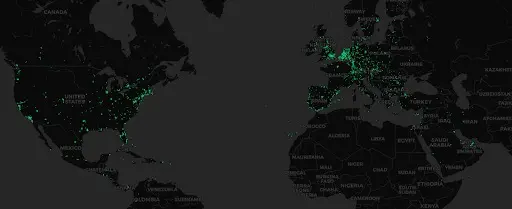
1.2 ISO
ISO (initial sensor offering) is an incentive program launched by Moonchain.com for IoT developers.
Before the ISO program, the main application scenarios of the MXC network were concentrated in ToB concepts such as smart cities, providing IoT intelligent solutions for applications like parking lots, trash bins, and streetlights in cities like New York, Seoul, and Shanghai.
The ISO program, benefiting from the powerful technical support of Layer3 zkEVM, provides convenient plugins and toolboxes, enabling more IoT developers to easily connect to Moonchain, which not only increases network demand and enhances network activity but also enriches the diversity of the MXC ecosystem.
The main contents of the ISO program include:
Developers can lock $MXC for financing.
Projects can issue their native tokens, and Miners can mine project tokens, choosing promising projects to invest quality network resources and receive project token incentives.
Developers can link their own Sensors to Moonchain, and miners on the network will be able to recognize and authenticate these Sensors.
$Crab is a recent ISO case released by MXC. Moonchain can collect water quality, animal activity, and feeding system information through sensors installed in the Yangcheng Lake crab farm. Meanwhile, miners can process this data to earn $Crab token mining rewards.
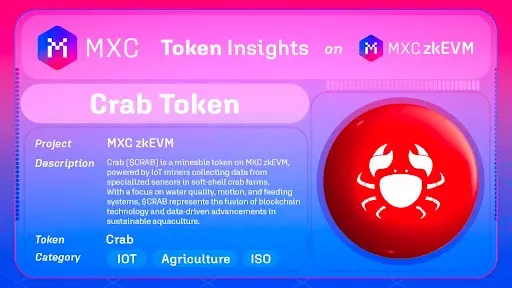
1.3 Smart Bidding System
The ISO program will bring a large number of IoT devices/Sensors to the network, generating significant network demand. MXC's Smart Bidding System can effectively accommodate this demand. IoT device owners can purchase network resources through market bidding, while Miners can prioritize serving those who bid higher. This allows for the allocation of different levels of network resources to IoT devices with varying network demands. For IoT devices that require high timeliness and transmission quality, they can obtain priority and stable network resources at a higher price; while for IoT devices that do not pursue response speed and can tolerate some data loss, they can opt for relatively delayed but cost-effective network solutions.
This design greatly improves the allocation efficiency of the entire network system, and the network resources in the hands of Miners can be maximally utilized. The price of the network is determined by the market supply and demand relationship and is guaranteed to be transparent and fair through blockchain technology.
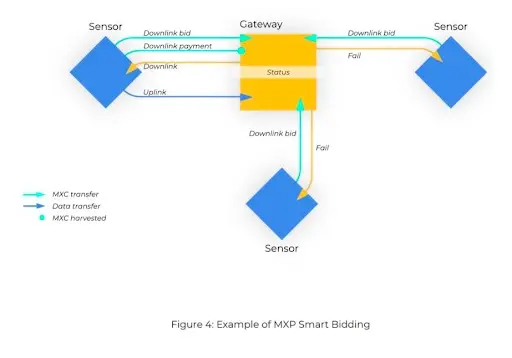
1.4 Data Market
In addition to balancing the supply and demand sides of the network, Moonchain also provides solutions for both sides of IoT data supply and demand—the Data Market builds a decentralized trading platform for data producers (Sensors/IoT devices) and data consumers (enterprises/analysts, etc.). The data collected by Miners from Sensors will automatically be listed in the data market in the form of NFTs, and data buyers can complete purchases through smart contracts.
This not only provides a fair and stable data trading venue for both sides of the data supply and demand through smart contracts but also opens up new profit sources for IoT devices, ultimately safeguarding the rights of data producers to control the data they generate.
2. Technical Features
2.1 LPWAN
MXC provides LPWAN (Low-power Wide-Area Network). Unlike the short-range, high-bandwidth WiFi we commonly use, or the high-energy-consuming and expensive 5G/4G/3G/LET, LPWAN is characterized by low power consumption, long communication distances, low cost, and low bandwidth, making it naturally suitable for low-bandwidth, long-distance, and numerous connected IoT devices. It is widely regarded as the future direction of the Internet of Things.
LPWAN is developed using LoRaWan, which is highly decentralized, allowing companies and individuals to deploy it without needing operators to auction frequencies. The coverage radius of base stations can reach 20 kilometers, and sensors on the network can last about 10 years on a single charge, making it an ideal type of IoT network.
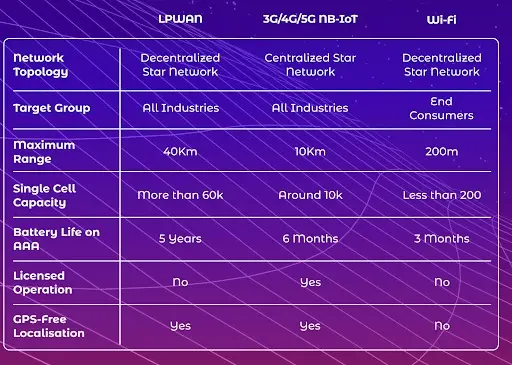
2.2 PoP Model
MXProtocol uses the PoP (Proof of Participation) model as a distribution mechanism to incentivize miners to participate in network activities. The protocol assesses the activity and participation of nodes in the network and gradually removes those with low participation.
According to the open-source code of the protocol, the factors affecting participation assessment include:
Online time;
The number of data transmissions and receptions;
Data quality (low loss and low latency);
In addition, the health value of Miners and the amount of $MXC in the fuel tank will also affect miners' mining rewards.
To ensure the trusted operation of hardware devices and maintain the security and fairness of the network, users can currently only mine using the M2 Pro Miner and NEO Miner jointly launched by MXC and MatchX, which is a common method adopted by most network infrastructures to maintain network security.
The advancement of the PoP consensus mechanism lies in ensuring the fairness of incentive policies, where miners' mining rewards are directly correlated with their contributions to the network, ensuring positive incentives and a win-win relationship.
2.3 Moonchain ------ Layer3 zkEVM
As a network infrastructure, MXC has chosen a middle path by building Layer3 on Arbitrum and utilizing Taiko to construct zkEVM, launching MXC Moonchain:
Layer 3 can inherit the security of Ethereum;
The network throughput is enhanced through Taiko ZK, improving Ethereum's scalability;
ZK technology ensures the correctness, completeness, and privacy of transactions;
In the DA module, IPNS is used for data storage, significantly reducing gas costs and further enhancing network throughput;
As a Type 1 zkEVM, it is fully compatible with Ethereum;
It has good cross-chain interoperability.
Through this design, MXC Moonchain has become a dedicated chain for DePIN projects within the Ethereum ecosystem, allowing DePIN projects focused on developing smart hardware to issue tokens on-chain. The advantages of MXC's dedicated chain are not only reflected in performance, cost, and cross-chain optimizations but also in the Ethereum ecosystem benefits that Layer 3 can reap. Tokens and NFTs issued by developers on the MXC chain will automatically integrate into Ethereum's liquidity and rich dApp ecosystem, which is crucial for the rapid growth of projects.
In addition to the incubation advantages for small and medium-sized projects, as a dedicated chain, MXC Moonchain can ensure the security and stability of the blockchain by limiting project types, which also helps attract large projects from conservative and stable entities like government agencies. These large projects can not only enhance the visibility of MCX but their high demand for throughput also contributes to the continuous development of MXC Moonchain.
As of the publication date, MXC zkEV has produced 350,727 blocks, with a total of 12,068 accounts and has issued 303 types of tokens, showing stable development.

https://explorer.mxc.com/stats
3. Token Economics
3.1 Supply
The total supply of $MXC is 2,664,965,800 tokens, which will be gradually completed within the first 24 months. According to official information, all $MXC are in an unlocked and circulating state, fully adhering to the PoP consensus mechanism.
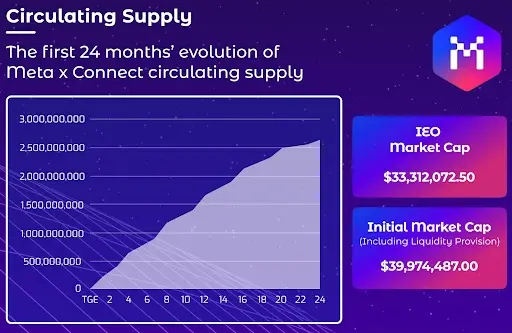
3.2 Token Use
As the platform's native token, $MXC plays an important role in the entire ecosystem. According to the author's understanding and summary, it currently has the following main functions:
Transaction medium: Using the MXC data network for data transmission requires payment in $MXC, i.e., "pay to use."
Mining incentives: Miners can earn $MXC as rewards for participating in network construction under the PoP mechanism.
Gas fees: All activities on the MXC chain use $MXC as gas.
Staking: Participating in ISO projects, BTC mining, and other activities requires staking a certain amount of $MXC as a project threshold.
Governance voting: $MXC holders can participate in community governance voting.
3.3 Distribution
According to the foundation's official documents, the token distribution is as follows:
|-----|-------| | 20% | Early investors | | 30% | Private sale | | 10% | Private ICO | | 20% | Team | | 20% | Foundation |
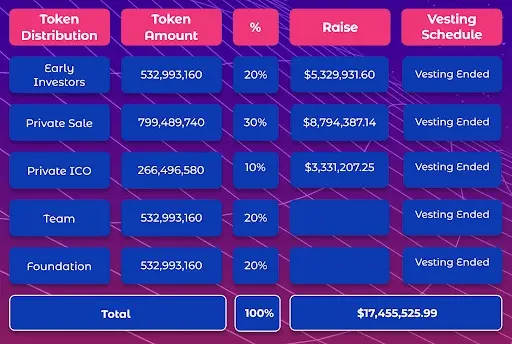
3.4 Burning
$MXC will maintain a total supply of 2,664,965,800 tokens, and any excess tokens will be burned to keep the total supply constant.
Additionally, MXC has a buyback mechanism, meaning that when tokens are transferred to centralized exchanges, the protocol will also burn an equivalent number of tokens to signify the scarcity of the tokens.
As of now, MXC has recorded the burning of 35,535,286 tokens. The more tokens that are burned, the faster the rate at which mining produces tokens, indicating higher network activity. Therefore, MXC has launched multiple rounds of activities to promote the burning of MXC tokens.
4. Competitive Analysis
With the continuous boom in the industry, the concept of dedicated chains for DePIN has gradually gained market recognition. In addition to MXC, established projects like IoTeX are also building dedicated chains for network and data transmission infrastructure. Furthermore, with leading projects like Helium and Render migrating to the Solana chain, Solana is often regarded as a DePIN chain. Here, we briefly introduce and compare these DePIN chains.
4.1 Solana
Solana is positioned as an all-purpose public chain, but its high performance has attracted numerous DePIN projects to take root, creating a strong network effect and a thriving DePIN ecosystem.
Solana is currently strong in the DePIN concept, with many leading projects in various subfields of DePIN established on Solana. Its advantages include performance and network effects, and the official stance of the Solana Foundation has repeatedly expressed strong support for DePIN projects, providing dedicated tracks for DePIN in hackathons. The launch of the Solana Mobile phone also offers many opportunities for various DePIN projects to develop and utilize. Additionally, for developers, compared to developing a dedicated DePIN chain, the mature token standards and well-tested ecosystem on Solana can save a significant amount of development and maintenance costs.
4.2 IoTeX
IoTeX is a long-established Layer 1 dedicated chain for DePIN. Its main goal is to build a decentralized IoT data platform aimed at providing privacy protection, security, and scalability for IoT devices.
Innovations in technology include:
Using a unique Blockchain-in-Blockchain architecture, allowing multiple independent sub-chains to run on the main chain, each optimized for different IoT application scenarios.
Adopting the PoSV (Proof of Stake Voting) consensus mechanism, where IOTX holders can run nodes to participate in elections to become Block Producers or stake tokens to candidate nodes and participate in governance through voting. By introducing voting and delegation mechanisms, PoSV enhances the security and decentralization of the network based on POS.
Through W3bstream, a ZK-based on-chain and off-chain interaction protocol launched by IoTeX, allowing IoT devices or dApps to process and compute data off-chain and submit the results for on-chain verification, achieving verifiable computation and data privacy protection for IoT devices.
Introducing TEE (Trusted Execution Environment) to ensure the secure execution of smart contracts through hardware isolation and encrypted signatures.
Through this design, the main participants in the ecosystem can safely and efficiently complete the following activities:
Block Producers: Publish and verify blocks, maintain the main chain.
Delegators: Stake IOTX tokens to support block producers.
Device owners: Link devices to the IoTeX network.
Service providers: Build IoT applications on sub-chains.
IoTeX was established in 2017 and has many successful use cases, such as collaborating with Ucam to launch blockchain-based security cameras, allowing users to have complete control over their video data. It has also partnered with Chainlink to provide trusted external data for IoT devices.
Conclusion
By comparing with Solana and IoTeX, we can see:
In terms of business model design, MXC has a broader business coverage. In addition to creating a closed loop from both network and data perspectives, it also attempts to further develop businesses like RWA, making it currently the most widely implemented public chain outside of the Solana ecosystem, while IoTeX focuses more on data utilization.
In terms of performance, with the completion of the Cancun upgrade, the previously criticized transaction costs of MXC have significantly decreased, with average transaction costs now stabilized between 1-2 MXC. However, compared to transaction costs on Solana and IoTeX, it is still relatively high, and the daily transaction volume also needs to catch up.
In terms of ecology, compared to Solana and IoTeX, which have breakout use cases like Mobile and Ucam, MXC's more well-known applications are still limited to ToB businesses like smart cities. We also hope that with the launch of the ISO program, more application attempts can be brought to the MXC ecosystem from different angles, achieving ecological prosperity sooner.
Currently, Solana has a circulating market value of 81.9 billion, IoTeX has a circulating market value of 730 million, and MXC has a circulating market value of only 54 million. MXC recently received a strategic investment of 10 million dollars from JDI Ventures, a fund focused on DePIN projects under blockchain hardware manufacturer JDI Global. If MXC can achieve more business implementations, there is significant growth potential in the future.
5. Risk Warning
The quality assurance of chips is crucial for the safe production of mining machines. If the chips have security flaws, malicious attackers may exploit them to invade and control the mining machines, affecting their stability. The security of the software systems customized for the chips should not be overlooked either. These require the project team to invest resources for strict oversight. Additionally, only when users reach a certain scale can the production costs of mining machines achieve economies of scale. Otherwise, it will increase the entry costs for users and create inventory pressure.
DePIN projects have high requirements for market value management of tokens. If the token price performs poorly, user participation will be low. If the token price rises too quickly, it may lack sustainability. The cryptocurrency market is influenced by various factors such as macroeconomics and market sentiment, leading to significant price fluctuations. These all place high demands on the project team to balance research and development, ecological construction, and market value management.
Currently, the L2 ecosystem in Ethereum is experiencing explosive growth, with severe liquidity fragmentation. Although MXC is currently developing Layer3 based on the most active Arbitrum in L2, which offers more autonomy, its ability to capture the development of the Ethereum ecosystem remains to be observed. In the current situation where major public chains use token incentives to attract attention, it is also crucial for the MXC team to plan a clear development route and find the right development positioning.
6. Summary
As a mature project that has been deeply involved in the DePIN industry for many years, MXC has achieved integration with the Ethereum ecosystem through the clever use of Layer3. In the midst of a frenzied bull market, enjoying the dual benefits of the DePIN concept and the Ethereum ecosystem, its market performance is worth paying attention to. Furthermore, Ethereum founder Vitalik's question about DePIN in March on Wrapcast has led the market to speculate whether the Ethereum ecosystem will participate in the competition in the DePIN sector. If so, for newly incoming IoT developers, MXC, with its broad business scope and mature framework, is a good choice. Whether MXC can seize the opportunity and successfully build a DePIN ecosystem on Ethereum remains to be seen.










